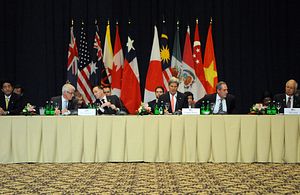Chinese President Xi Jinping continued to emphasize regional connectivity – including the completion of a free trade area spanning the entire Asia-Pacific region – at this year’s Asia Pacific Economic Cooperation (APEC) summit, even as the United States and other partners celebrated the conclusion of their own trade deal.
Xi also stressed a potential Free Trade Area of the Asia Pacific (FTAAP) last year, when China was hosting the APEC summit. In 2014, Chinese officials pushed for movement on FTAAP, arguing that it would reduce the fragmentation caused by the wealth of separate, non-inclusive FTAs in the region – including the Trans-Pacific Partnership, which saw negotiations concluded earlier this year. China, which is not a member of the TPP, views FTAAP as the holy grail of trade agreements, and a way to effectively void the impact of TPP.
Despite rumors of U.S. opposition to the idea of FTAAP, the Leaders’ Declaration issued after the 2014 APEC summit in Beijing included an agreement “to launch a collective strategic study on issues related to the realization of the FTAAP.” The results of the study are scheduled to be announced by the end of 2016.
At this year’s APEC meeting, Xi picked up where he left off, with a continued push in favor of the FTAAP. In a keynote address at the APEC CEO summit on Wednesday, Xi outlined China’s vision for economic growth in the Asia-Pacific. The central theme of Xi’s speech was an appeal for economic unity among the Asia-Pacific economies. “All economies in the region must act in a responsible manner and work in unison to promote global growth,” Xi said in his speech.
Part of working in unison, according to China’s blueprint, is an all-inclusive free trade agreement. “With various new regional free trade arrangements cropping up, worries about fragmentation are on the increase,” Xi said. “We need to accelerate the realization of FTAAP and take regional economic integration forward.”
Xi also urged all parties to “make free trade arrangements open and inclusive to the extent possible with a view to enhancing economic openness in our region and upholding the multilateral trading regime” – an implicit criticism of the TPP, which purposefully opted for “high standards” rather than inclusivity.
At the same time, however, Xi held up China’s progress on its own free trade agreements. After recently concluding FTAs with Australia and South Korea, Xi said China will work “to finish at an early date negotiations on the Regional Comprehensive Economic Partnership (RCEP) while accelerating talks on a China-Japan-ROK FTA.”
In Xi’s speech, FTAAP meshes with China’s “Belt and Road” strategy as part of a move toward economic integration. FTAAP will reduce policy barriers to trade, while the “Belt and Road” seeks to facilitate the physical movement of goods thanks to increased infrastructure connectivity. “Through implementing the ‘Belt and Road’ Initiative, we will go for even broader, deeper, and more sophisticated cooperation at the regional level,” Xi promised.
Xi’s emphasis on the FTAAP was juxtaposed with a celebration of the TPP on the sidelines of APEC. U.S. President Barack Obama called the trade agreement “one of the most important steps we can take to grow our economies” in remarks before the CEO summit.
The leaders of the 12 members of TPP — Australia, Brunei, Canada, Chile, Japan, Malaysia, Mexico, New Zealand, Peru, Singapore, the United States, and Vietnam – also met on the sidelines of APEC to mark the conclusion of TPP negotiations. They issued a statement that praised the trade deal for “setting high-standard trade rules that will support 21st-century commerce and providing ambitious liberalization of trade and investment.”
“[T]hrough TPP we are creating a new and compelling model for trade in one of the world’s fastest growing and most dynamic regions,” the statement continued.

































